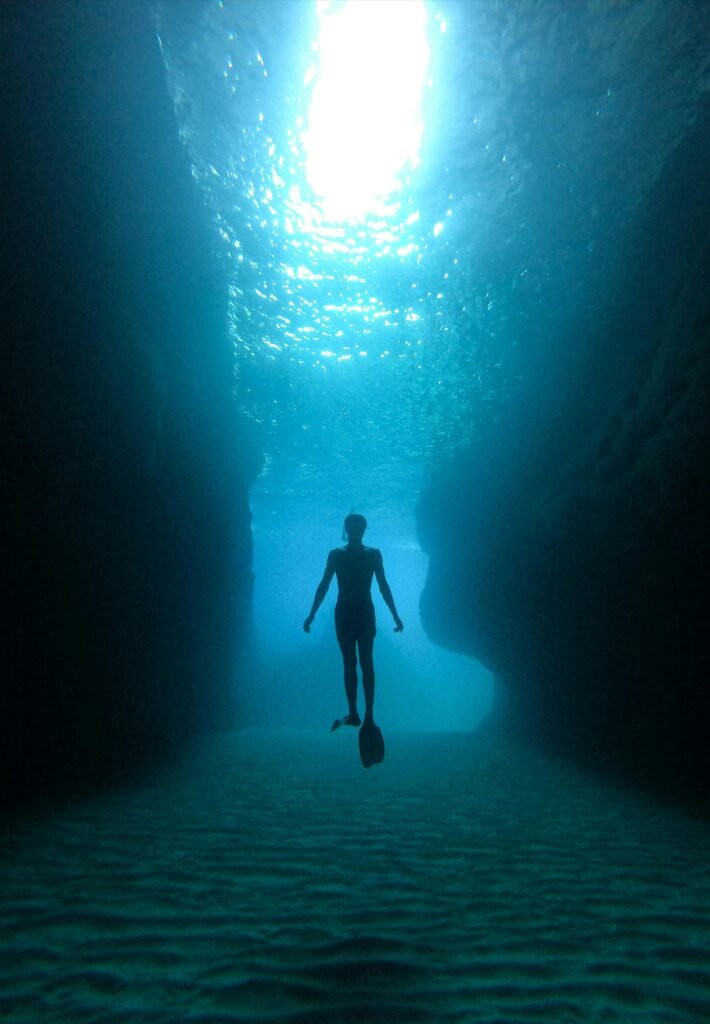The Power of Breath Control

Underwater modeling is all about holding your breath, controlling your movements, and remaining still while fighting the natural urge to panic. There’s an inherent pressure to stay calm in an environment where it’s easy to lose your breath, your focus, or even your confidence. Believe it or not, this translates perfectly to voice acting!
Whether it’s recording an intense scene or performing a difficult monologue, maintaining breath control and emotional presence is critical. You can’t rush through your lines (something that’s easier said than done); so you need to pace your breath, adjust your energy, and communicate your character’s emotions fully.
It’s all about finding that inner stillness while conveying something powerful and meaningful!
Staying Calm Under Pressure

Both underwater modeling and voice acting demand a unique ability to stay calm under pressure.
During an underwater shoot, there’s no room for anxiety. If you’re not calm, your movements will be stiff, and the shot won’t work.
If you panic, you’ll need to rush up for air and could run into a plethora of problems for you and the crew.
Similarly, in voice acting, if you let nerves take over, your performance will feel disconnected and you could risk jeopardizing the final outcome of the project.
The ability to focus, clear your mind, and use your breath to ground yourself is something that transcends both practices.
In both environments, every moment feels like an opportunity to either rise above or succumb to pressure. You never know what will come up and you have to be ready at all costs, so take a deep breath and get ready to go all in!
Fun Fact: In acting, particularly voice acting, the term “nervous energy” is often used to describe the jitters actors experience. But interestingly, some voice actors channel that nervous energy into powerful, dynamic performances, proving that a little pressure can sometimes be a great motivator!
The Importance of Breathing
Every breath counts in underwater modeling. You learn to manage every breath you take because the longer you can stay beneath the surface, the better chance of the photographer snapping that perfect shot they hired you to get! This same breathing discipline is just as crucial when I’m voice acting for a project. A deep, controlled breath before delivering lines helps create a more authentic, grounded performance.
Whether it’s a character’s emotional scene or a comedic delivery, having the right breath at the right moment can elevate the energy, clarity, and delivery. The ability to control your breathing is a powerful tool that improves both my modeling and acting work.
Think about how you breathe when you are talking casually to a friend about something versus when a traumatic experience happened and you can barely speak due to stress and fear. Breath has the power to change EVERYTHING!
Fun Fact: Voice actors often do breathing exercises to improve their delivery. Did you know that diaphragmatic breathing is the key to a strong, clear voice? Breath Control not just for singers or public speakers, it’s also essential for actors to project their voice and control their delivery.

Trusting Your Instincts
One of the most surprising lessons I’ve carried from underwater modeling to voice acting is the importance of trusting your body and instincts. Underwater, I don’t have the luxury of thinking too much about what I’m doing.
Instead, I must react instinctively to the situation and the environment. If my hair gets caught in something or material gets wrapped around my leg, I have to stay calm and act accordingly to make sure that my breath stays in control. This will allow me to judge the situation and call for help, if needed!
That’s what voice acting demands too – trusting your instincts and responding to the material without overthinking.
There’s a magic in both fields when you stop trying to control every aspect and simply allow yourself to be in the moment. For when you start dipping into panic mode, you will lose site of the mission placed in front of you and head into panic mode.
Fun Fact: Did you know that voice actors often don’t see the animation or scene they’re recording for? Instead, they rely purely on their instincts, imagination, and the script in front of them.
It’s all about creating an emotional connection with the material, just like in underwater modeling, where you have to feel your way through the experience without overthinking it.
3 Tips for Improving Breath Control:
As you’ve learned, breath counts in underwater modeling. You learn to manage every breath you take because the longer you can stay beneath the surface, the better chance of the photographer snapping that perfect shot they hired you to get!
This same breathing discipline is just as crucial when I’m voice acting for a project. A deep, controlled breath before delivering lines helps create a more authentic, grounded performance! Here are three ways you can try improving your breath control whether you’re jumping in the water or talking behind the mic!

1. Diaphragmatic Breathing:
Diaphragmatic breathing, or “belly breathing,” is key to using your breath effectively in both modeling and voice acting. It helps support a strong, clear voice, and ensures you’re breathing deeply enough to calm your nerves and enhance your performance.
2. Practice Breath Holds:
For underwater modeling, practicing breath holds is essential for improving your underwater endurance. Similarly, in voice acting, learning to hold your breath during a dramatic pause can create suspense and allow you to focus on your delivery without rushing. Just like an athlete, we have to train and practice to get better, this includes something as simple (or not so simple) as your breath holds.
3. Sync Your Breathing with Your Movement:
When you’re underwater, your body’s movements are synced with the breath inside you. This same concept applies to voice acting, where syncing your breath with your delivery can create a more organic performance. Take a deep breath before each line and time your delivery to match your natural rhythm in the scene.
The Connection Between Both Worlds
Breath control hits from the moment you sink into your performance – no matter where it may be. So, whether I’m submerged in water or behind the mic voice acting, I know that the challenges of staying calm under pressure, controlling my breath, and trusting my instincts will serve me well.
The connection between underwater modeling and voice acting is profound, reminding me that staying grounded is key to excelling in both. And the more I can connect with my body and breath, the more I can give in my performances, whether it’s on screen, in front of the camera, or through the microphone.
Fun Fact: Some of the most famous voice actors, like Tara Strong (known for voicing “Raven” in Teen Titans) and Mark Hamill (the iconic Joker voice actor), have also credited their performances to tapping into their physical presence and instincts. So, next time you’re in front of the mic, remember that your body and breath are just as important as your voice!
Want to see some of my voiceovers and underwater work? Head over to my YouTube Channel – Simply Shannon Entertainment LLC, and see how my two worlds collide.



